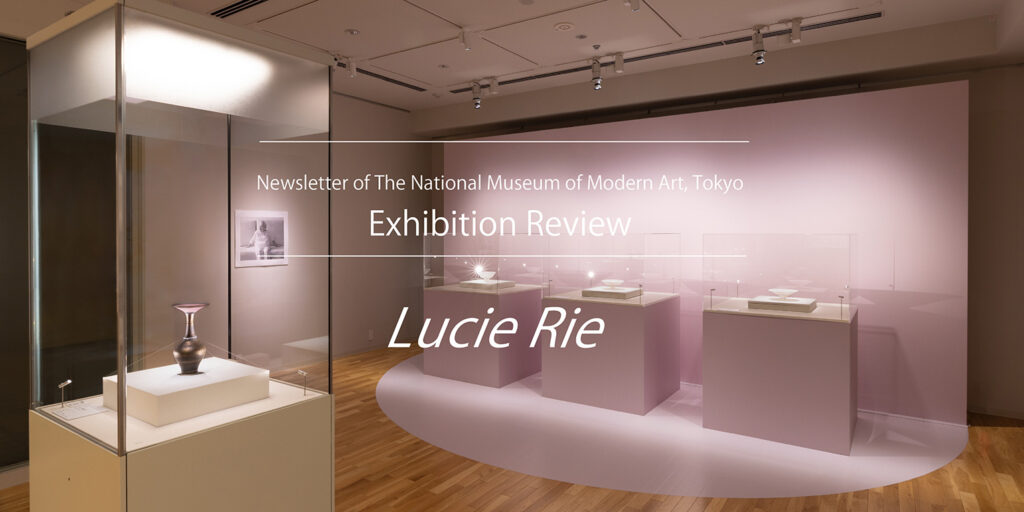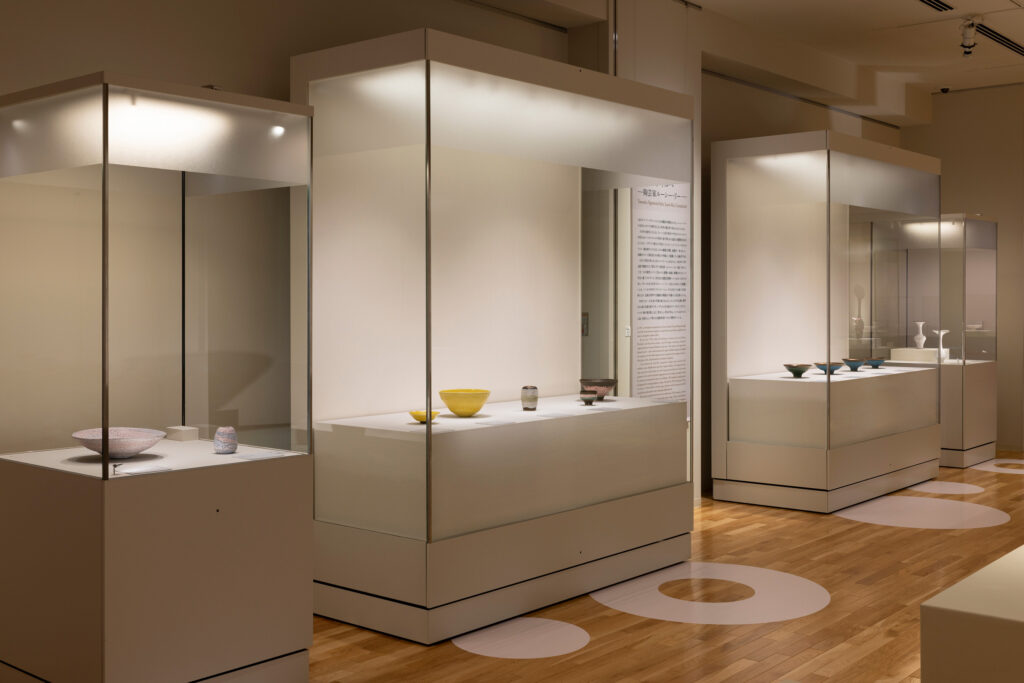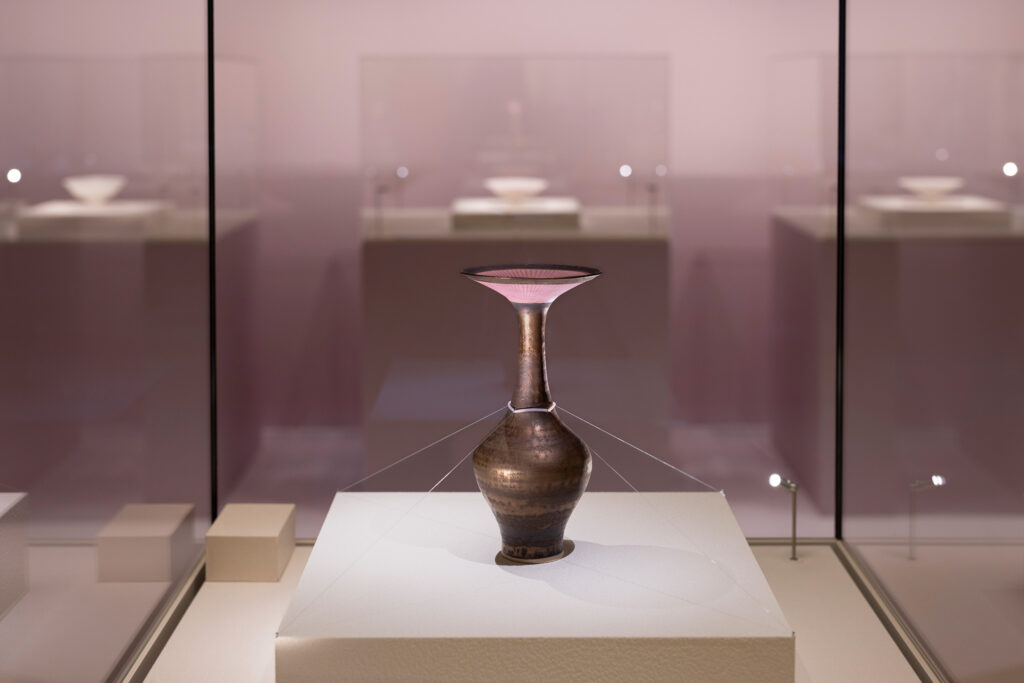Watch, Read, Listen
Newsletter of The National Museum of Modern Art, Tokyo Exhibition Review The Encounter Between Lucie Rie and Collector Paul Dauer
Back
Lucie Rie: Elegant Vessels Fusing East and West is an exhibition that explores the evolution of Lucie Rie’s practice, from her early works made during her years in Vienna to her engagement with ceramic artists from around the world, including Hamada Shoji, which ultimately led to the development of her signature decorative style.
Our museum contributed five works to the exhibition, including two from the Sharon and Paul Dauer Collection, which became part of our holdings in 2024. The two newly acquired works were Bowl (work number 49, c. 1968), a slightly larger vessel with a raised foot ring and sgraffito (in which layers of glaze or slip are scratched through to reveal the clay or glaze beneath) decoration in manganese glaze applied to both the exterior and interior, and Bowl (work number 112, c. 1981), featuring a spiral pattern shaped on a potter’s wheel using two colors of clay. Both were previously shown in Serene Beauty: Lucie Rie Retrospective, held in 2002 to commemorate the centennial of her birth.

Photo by Ishikawa Koji
These two works were donated in 2024 by collector Paul Dauer and his wife Sharon, residents of California’s capital Sacramento. While working as a lawyer, Dauer had been collecting a wide range of modern ceramics from Europe, the United States, and Japan since his youth. He first met Lucie Rie in 1969, an encounter he later recounted in a lecture at this museum:
“Go away! You’re late!” came a voice from inside the house.
The Dauers arrived more than 20 minutes late after a bomb scare on the train to Rie’s home and a stop to buy flowers along the way. When they finally reached her house and rang the doorbell, Paul explained the reason for their delay to the still-closed door, apologized, and was just leaving the flowers on the doorstep when a voice from inside called out, “Go! But come back in twenty minutes.” When they returned, Rie welcomed them in. Dauer recalled:
On emerging into her living room, I exclaimed that she had put the irises which we had brought into one of her pots. She was puzzled at my surprise that she was using the vase for its intended function. “What else would you do with the pots?,”she queried and could only shake her head, when I postulated that as art objects, they should be displayed for their beauty alone. … There could be no pot segregated from its function. …and joined the ranks of museum collections she came to realize, if not wholly accept, that there existed an artistic integrity separate from the functionality of a pot. ¹
The initial “Go away!,” spoken with firm resolve, suggests that Rie was a woman of iron will. Yet sending them off and then, within twenty minutes, arranging the flowers they had left at her door also conveys ladylike kindness. In her exchange with Dauer about the functional and aesthetic value of vessels, in which they discussed the balance between utility and beauty, one can sense a shift in her thinking. After World War II, Rie embarked on a new path of ceramics as art, incorporating spatial and design elements while retaining the form of functional vessels shaped on the potter’s wheel. Dauer’s anecdote reflects how the artistic dimension of ceramics gradually came to occupy a greater place in her work, offering an intriguing glimpse into the development of modernist ceramics from the 1970s onward.

Photo by S&T Photo
Their conversation also turned to the subject of glaze. Dauer noted that many collectors favored a bold pink, as seen in Footed Bowl with Inlaid Pink Horizontal Circles with Bronze Running Rim (work number 97, c. 1975–79), a pink bowl with a bronze rim and a band of turquoise. Rie, however, told him that she preferred a softer, more delicate shade.²
In the autumn of 2025, at the exhibition where Lucie Rie’s works were displayed with precision and care, I found myself recalling this exchange between collector and artist and searching for pieces in her favored pale pink. In this exhibition, both Footed Bowl with Inlaid Pink Horizontal Circles with Bronze Running Rim and Bowl with Pink Stripes (work number 98, c. 1975–80) reflected the conversation between Dauer and Rie. This decorative style, which emerged in the 1970s, is characterized by vivid turquoise bands serving as accents and by the striking effect produced by the interplay of pink and bronze glazes. Despite being small enough to fit in the palm of one’s hand, these works radiate an undeniable presence. In addition to the splendid color balance, the bronze glaze in places flows over the pink, creating the impression of movement across the precisely ordered design. This is indeed a decorative sensibility that fuses East and West.

Photo by Ishikawa Koji
In her inlaid works, Rie varied the color of the inlay after carving into the surface, selecting different tones depending on the work. For example, in Footed Bowl with Inlaid Pink Horizontal Circles with Bronze Running Rim (work number 97, c. 1975–79), she inlaid pink clay and applied a glaze of a similar shade, while in Bronze Glazed Vase (work number 108, c. 1980), she chose a gray inlay instead. This shade of gray accentuates the lines, resonating with the vessel’s vertical form and imparting a more dynamic sense of movement.

Photo by Ishikawa Koji
Even when making her smallest decorative lines, Rie carefully weighed their overall effect within each work. In this exhibition, we invite you to look closely at the details in which Rie’s exquisite touch and ingenuity come fully to life.
Notes
1 Paul F. Dauer, Recollections on the Centennial of the Birth of Lucie Rie, privately published, 2002, p. 12
2 Ibid., p. 33.
Reference: Paul F. Dauer, “Not in My Lifetime,” Ceramics: Art and Perception, no. 38, 1999.
(Gendai no me, Newsletter of The National Museum of Modern Art, Tokyo No.640)
Release date :


